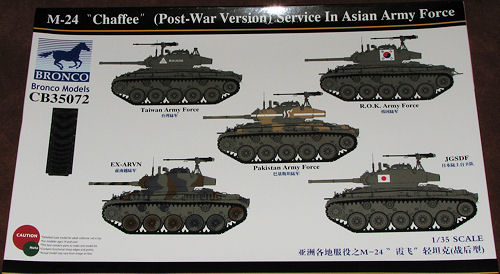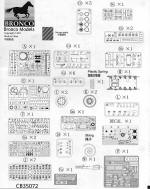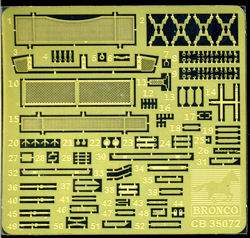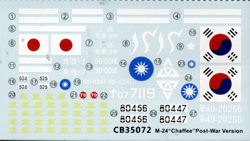
| KIT #: | CB 35072 |
| PRICE: | $70.00 SRP |
| DECALS: | Seven options |
| REVIEWER: | Scott Van Aken |
| NOTES: |

| HISTORY |
The Light Tank M24 was an American light tank used during World War II and in postwar conflicts including the Korean War and with the French in the War in Algeria and First Indochina War. In British service it was given the service name Chaffee, after the United States Army General Adna R. Chaffee, Jr., who helped develop the use of tanks in the United States armed forces.
The M24 Chaffee was intended to replace the aging and obsolete Light Tank M5 (Stuart) which was used in supplementary roles. The first thirty-four M24s reached Europe in November 1944 and were issued to the U.S. 2nd Cavalry Group (Mechanized) in France. These were then issued to F Company, 2nd Cavalry Reconnaissance Battalion and F Company, 42nd Cavalry Reconnaissance Battalion which each received seventeen M24s. During the Battle of the Bulge in December 1944, these units and their new tanks were rushed to the southern sector; two of the M24s were detached to serve with the 740th Tank Battalion of the U.S. First Army.
The M24 started to enter widespread issue in December 1944 but they were slow in reaching the front-line combat units. By the end of the war many armored divisions were still mainly equipped with the M5. Some armored divisions did not receive their first M24s until the war was over.
Reports from the armored divisions that received them prior to the end of hostilities were generally positive. Crews liked the improved off-road performance and reliability, but were most appreciative of the 75 mm main gun, as a vast improvement over the 37 mm. The M24 was not up to the challenge of fighting German tanks, but the bigger gun at least gave its crews a chance to fight back when it was required. The M24's light armor made it vulnerable to virtually all German tanks, anti-tank guns, and hand-held anti-tank weapons. The contribution of the M24 to winning the war in Europe was insignificant, as too few arrived too late to replace the worn-out M5s of the armored divisions.
In the Korean War M24s were the initial U.S. tanks directed to combat the North Korean T-34-85s. The M24 fared poorly against these better armed and better armored medium tanks. M24s were more successful later in the war in their reconnaissance role, supported by heavier tanks such as the M4, M26, and M46.
Like other successful World War II designs, the M24 was supplied to many armies around the globe and was used in local conflicts long after it had been replaced in the U.S. Army by the M41 Walker Bulldog. France employed its M24s in Indo-China in infantry support missions, with good results. They employed ten M24s in the Battle of Dien Bien Phu. In December 1953 ten disassembled Chaffees were transported by air to provide fire support to the garrison. They fired about 15,000 shells in the long siege that followed before the Viet Minh forces conquered the camp in May 1954. France also deployed the M24 in Algeria. The last time the M24 is known to have been in action was in the Indo-Pakistani War of 1971, where some 66 Pakistani Chaffees stationed in Bangladesh were easy prey for Indian Army T-55s, PT-76s, and anti-tank teams. Although both Iran and Iraq had M24s prior to the Iran–Iraq War, there is no report of their use in that conflict.
| THE KIT |
 This
is the third boxing of this kit, the first being WWII, the second British and
This
is the third boxing of this kit, the first being WWII, the second British and now this one for Asian armed forces. A coming kit is a Korean War version. As
with all Bronco kits, this one has superb molding. It is also a multi-media kit
with etched brass included. To say that this is very detailed would almost be an
understatement. The etched fret, for example, contains small casting numbers to
be applied to the forward transmission housing.
now this one for Asian armed forces. A coming kit is a Korean War version. As
with all Bronco kits, this one has superb molding. It is also a multi-media kit
with etched brass included. To say that this is very detailed would almost be an
understatement. The etched fret, for example, contains small casting numbers to
be applied to the forward transmission housing.
The kit suspension is designed to be able to move both up and down as well as to have the wheels, sprocket and idler rotate. This means one has to be quite careful when assembling the rather parts-intensive tracks. They are molded in such a way that they can articulate properly. I found it quite nice that Bronco has provided molds for some of the etched brass, such as those pieces that are to be used for light guards. The rest of the main and smaller fret (small one not shown) are for things like engine intake grills as well as various brackets and hand holds. I did notice that for some of the finer etched pieces, there are alternate injected plastic bits as p.e. is sometimes more than the modeler wants to deal with.
All of the hatches can be posed open or closed and some of these are moveable. One will also need to fill various holes and such, with this clearly shown in the instructions. There are also some differences between tanks operated by the various decal options so one will be wise to pick the option one wants prior to getting too involved in the build.
Another nice option is the placement of the very detailed .50 caliber external machine gun. It can be either on the tripod mount or place on a pedestal. This may be depending on the option you choose to build, though nothing is specified in the instructions. The main gun is a small model in and of itself with a nicely molded styrene recoil spring. A full breech assembly is provided, despite the kit being a curbside with no interior detailing. An additional option is for the main antenna mount and a rear cargo area with one being a photo etch basket of sorts. You also get jerry cans as well as ammo cans and depending on the option, the latter can be mounted on the hull.
 Bronco's
instructions are among the best in the industry. There are 45 construction steps
with each one indicating any modifications or options. I find them to be quite
clear in what goes where and especially in what areas not to cement if you want
the parts to move. There are options for tanks of five nations, all of them with
a base of Olive Drab. As you can see by the box art, those are for Taiwan, South
Korea, Pakistan, South Vietnam and Japan. The South Vietnamese and Japanese
tanks each have two options. I would do the Japanese one just to do battle with
Godzilla as in the movies. Decals are nicely printed and each of the seven
markings options has its own painting and placement page. Bronco offers paint
references from several manufacturers and just about all the color information
for the kit is in the painting page, as seems to be typical for many armor kits
from China nowadays.
Bronco's
instructions are among the best in the industry. There are 45 construction steps
with each one indicating any modifications or options. I find them to be quite
clear in what goes where and especially in what areas not to cement if you want
the parts to move. There are options for tanks of five nations, all of them with
a base of Olive Drab. As you can see by the box art, those are for Taiwan, South
Korea, Pakistan, South Vietnam and Japan. The South Vietnamese and Japanese
tanks each have two options. I would do the Japanese one just to do battle with
Godzilla as in the movies. Decals are nicely printed and each of the seven
markings options has its own painting and placement page. Bronco offers paint
references from several manufacturers and just about all the color information
for the kit is in the painting page, as seems to be typical for many armor kits
from China nowadays.
| CONCLUSIONS |
This is, by far, the most detailed kit of the Chaffee yet produced and it will be hard to see how it will be topped. To me, this is one of the neatest looking tanks ever built, but perhaps I have been subliminally affected by all those war movies (like Guns of Navarrone) and quality Japanese monster movies (Godzilla, Mothra, and Rodan) that used these tanks in their production. Regardless, it is a beauty and if you want a superlative model of this light tank and have the patience for all the parts, then this is the one for you.
| REFERENCES |
http://en.wikipedia.org/wiki/M-24_Chaffee
November 2012
Thanks to www.dragonmodelsusa.com for the preview kit. Get yours at your local shop or on-line retailer.
If you would like your product reviewed fairly and fairly quickly, please contact the editor or see other details in the Note to Contributors.